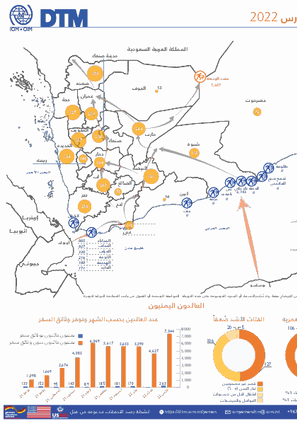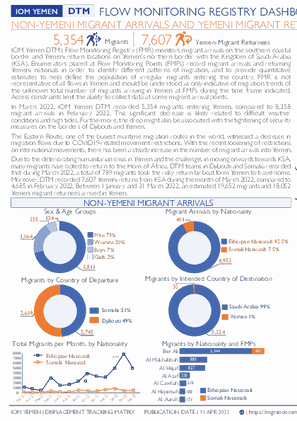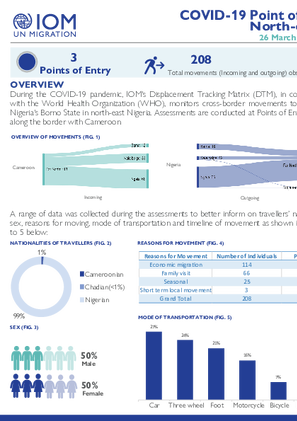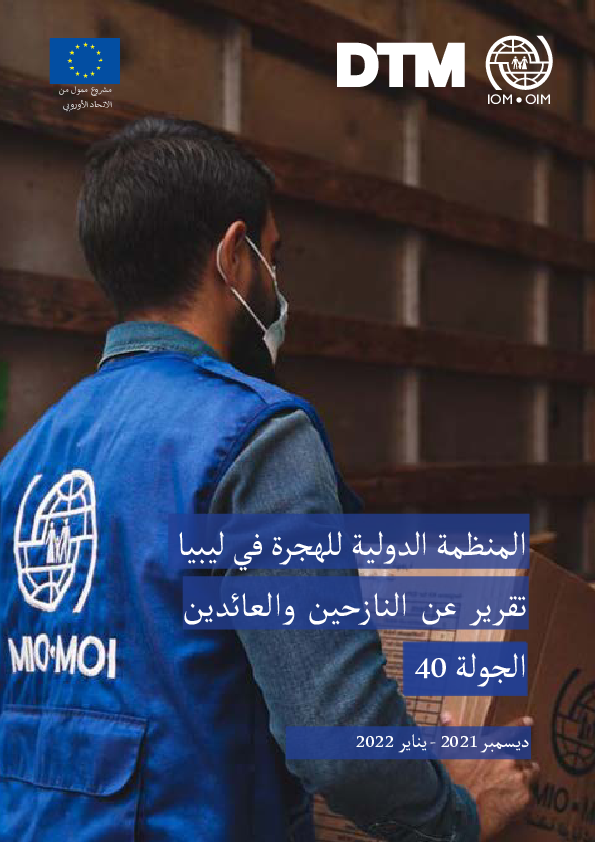-
Countries
-
Data and Analysis
-
Special Focus
-
Crisis Responses

Contact
DTM Nigeria, AllUsersInDTMNigeria@iom.int
Language
English
Location
Nigeria
Period Covered
Nov 16 2021
Dec 30 2021
Activity
- Mobility Tracking
- Baseline Assessment
IOM manages the Displacement Tracking Matrix (DTM) in Nigeria and other countries around the world, to support humanitarian
communities with data on displacement and mobility. This information management product determines the status, locations,
and needs of people affected by the ongoing conflict in north-west and north-central Nigeria.
As of 30 December 2021, the DTM has identitied 969,757 IDPs (157,519 households) across Benue, Kaduna, Kano, Katsina, Plateau, Nasarawa, Sokoto and Zamfara States. This represents an increase of 1 per cent (983,701 individuals) since the Round 8 assessment.
North-central And North-west Zones Site Assessment Dashboard 9
Contact
DTM Yemen, iomyemendtm@iom.int
Location
Yemen
Activity
- Flow Monitoring Survey
- Flow Monitoring
- Mobility Tracking
Period Covered
Mar 01 2022 -Mar 31 2022
IOM Yemen DTM’s Flow Monitoring Registry (FMR) monitors migrant arrivals on the southern coastal border and Yemeni return locations on Yemen's northern border with the Kingdom of Saudi Arabia (KSA). Enumerators placed at Flow Monitoring Points (FMPs) record migrant arrivals and returning Yemeni nationals in order to identify different patterns of migration, and to provide quantitative estimates to help define the population of irregular migrants entering the country. FMR is not representative of all flows in Yemen and should be understood as only indicative of migration trends of the unknown total number of migrants arriving in Yemen at FMPs during the time frame indicated. Access constraints limit the ability to collect data at some migrant arrival points.
In March 2022, IOM Yemen DTM recorded 5,354 migrants entering Yemen, compared to 8,358 migrant arrivals in February 2022. This significant decrease is likely related to difficult weather conditions and high tides. Furthermore, the drop might also be associated with the tightening of security measures on the borders of Djibouti and Yemen.The Eastern Route, one of the busiest maritime migration routes in the world, witnessed a decrease in migration flows due to COVID19-related movement restrictions. With the recent loosening of restrictions on international movements, there has been a steady increase in the number of migrant arrivals into Yemen.
Due to the deteriorating humanitarian crisis in Yemen and the challenges in moving onwards towards KSA, many migrants have opted to return to the Horn of Africa. DTM teams in Djibouti and Somalia recorded that during March 2022, a total of 789 migrants took the risky return by boat form Yemen to travel home. Moreover, DTM recorded 7,607 Yemeni returns from KSA during the month of March 2022, compared to 4,685 in February 2022.
Between 1 January and 31 March 2022, an estimated 19,652 migrants and 18,052 Yemeni migrant returnees arrived in Yemen.
Population Groups
Survey Methodology
Unit of Analysis Or Observation
Type of Survey or Assessment
Keywords
Geographical Scope
Administrative boundaries with available data
The current dataset covers the following administrative boundaries

Contact
DTM Yemen, iomyemendtm@iom.int
Language
Arabic
Location
Yemen
Period Covered
Mar 01 2022
Mar 31 2022
Activity
- Flow Monitoring Survey
- Flow Monitoring
- Mobility Tracking
تعمل مصفوفة تتبُع النزوح الخاصة بالمنظمة الدولية للهجرة في اليمن على مراقبة المواقع الرئيسية التي يصل عبرها المهاجرون على الحدود الساحلية الجنوبية، و مواقع العائدون اليمنيون والموجودة على الحدود الشمالية لليمن مع المملكة العربية السعودية. يُراقب الباحثون المتمركزون في نقاط رصد تدفق وصول المهاجرين والمواطنين اليمنيين من أجل التعرف على الأنماط المختلفة للهجرة وتقديم تقديرات كمية للمساعدة في تحديد عدد المهاجرين غير النظاميين في البلد. لا تمثل نقاط التدفق جميع التدفقات في اليمن ويجب فهمها على انها مؤشر فقط لاتجاهات الهجرة للعدد الاجمالي الغير معروف للمهاجرين الذين يصلون الى اليمن في نقاط مراقبة التدفق في فترة التقرير. والجدير بالذكر أن القيود المفروضة على الوصول تَحُد من القدرة على جمع البيانات في بعض نقاط وصول المهاجرين.
في مارس 2022 ، سجلت مصفوفة تتبع النزوح التابعة للمنظمة الدولية للهجرة في اليمن 5,354 مهاجرًا دخلوا اليمن ، مقارنة بـ 8,358 مهاجرًا في فبراير 2022. يعود الانخفاض الكبير في عدد المهاجرين في مارس 2022 مقارنةً بشهر فبراير 2022 بسبب تغيرات احوال الطقس والمد والجزر بالاضافة الى زيادة الإجراءات الأمنية على سواحل اليمن وجيبوتي.
شهد الطريق الشرقي ، أحد أكثر طرق الهجرة البحرية ازدحامًا في العالم ، انخفاضًا في تدفقات الهجرة بسبب قيود الحركة المرتبطة بكورونا COVID19مع تخفيف القيود مؤخرًا على التحركات الدولية ، كانت هناك زيادة مطردة في عدد المهاجرين الوافدين إلى اليمن. بسبب الأزمة الإنسانية المتدهورة في اليمن والتحديات في المضي قدمًا نحو المملكة العربية السعودية ، اختار العديد من المهاجرين العودة إلى القرن الأفريقي. سجلت فرق مصفوفة تتبع النزوح في جيبوتي والصومال خلال مارس 2022 ، تسجيل 789 مهاجرا عائداً بالقارب من اليمن. بالإضافة إلى ذلك ، سجلت مصفوفة تتبع النزوح حوالي 7,607 يمني عادوا من المملكة العربية السعودية خلال شهر مارس 2022، مقارنة بـ 4,685 في فبراير 2022. خلال الفترة بين 1 يناير و 31 مارس 2022، وصل ما يقدر بـ 19,652 مهاجرًا و 18,052 يمنيًا عائداً إلى اليمن.
حيث مثل عدد المهاجرين من إثيوبيا 92.5% في المائة و 7.5 في المائة من الصوماليين. كانت غالبية المهاجرين من الذكور (71 ٪) ، مع (20) من النساء ، و سبعة في المائة من الأولاد واثنين في المائة من الفتيات اللواتي كنا ايضاً من ضمن المسافرين.
خلال فترة التقرير في مارس 2022، شوهد وصول 2,745 مهاجرا من الصومال وتم تسجيلهم في نقطة مراقبة التدفق في بئر علي في محافظة شبوة. بينما شهدت نقاط مراقبة التدفق بمديرية المضاربة والعارة بمحافظة لحج وصول عدد 2,609 مهاجرا وصلوا من جيبوتي , حيث تم تسجيل 885 في المخاباه ؛ وا 827 في الحجاف ؛وا 330 في العزاف ؛وا 216 في الكوحه ؛ وا 180 في الهجيمه ؛ وا 171 في العاره.
المنهجيــة:
تهدف منهجية تتبع النزوح العالمية إلى التعرف على المناطق التي تحدث فيها الهجرة الداخلية والهجرة العابرة للحدود والهجرة الإقليمية. وتُنَفَذّ تقييمات التنقل للمناطق على المستوى الوطني. ومن ثم تقوم فرق مصفوفة التتبع بجمع المعلومات على المستوى المحلي للتعرف على نقاط العبور الرئيسية. يجمع الباحثون الميدانيون البيانات من مُدلين رئيسين بالمعلومات في نقاط رصد التدفق: ويمكن للمُدلين الرئيسيين ان يكونوا افرادً يعملون في النقل او موظفون في الجمارك او افرادً يعملون في قوارب او المهاجرون انفسهم. تُجمع البيانات باستخدام استمارة بسيطة و بالملاحظة المباشرة وهو ما يُسَهل عملية التحليل.
القيــــــود:
يجب تفسير البيانات المستخدمة في هذه العمليات كتقديراتً فقط، وانها تمثل فقط جزءاً من اجمالي التدفق الذي يمر عبر اليمن. ولذلك، ان التغطية الزمنية والمساحية غير مكتملة. وبالإضافة إلى ذلك، بالرغم من ان البيانات تُجمع بشكل يومي، إلا انها تُجمع فقط خلال ساعات الذروة. وإن نسبة التدفقات التي تحدث في الساعات التي لم تتم تغطيتها، لا تُمَثَل هنا. أما البيانات المتعلقة بالضُعف فهي ترتكز على الملاحظة المباشرة ويجب ان تفُهم بصفتها بيانات دلالية في المقام الأول.

Contact
DTM Yemen, iomyemendtm@iom.int
Language
English
Location
Yemen
Period Covered
Mar 01 2022
Mar 31 2022
Activity
- Flow Monitoring Survey
- Flow Monitoring
- Mobility Tracking
In March 2022, IOM Yemen DTM recorded 5,354 migrants entering Yemen, compared to 8,358 migrant arrivals in February 2022. This significant decrease is likely related to difficult weather conditions and high tides. Furthermore, the drop might also be associated with the tightening of security measures on the borders of Djibouti and Yemen.
The Eastern Route, one of the busiest maritime migration routes in the world, witnessed a decrease in migration flows due to COVID19-related movement restrictions. With the recent loosening of restrictions on international movements, there has been a steady increase in the number of migrant arrivals into Yemen.
Due to the deteriorating humanitarian crisis in Yemen and the challenges in moving onwards towards KSA, many migrants have opted to return to the Horn of Africa. DTM teams in Djibouti recorded that during March 2022, a total of 789 migrants took the risky return by boat form Yemen to travel home. Moreover, DTM recorded 7,607 Yemeni returns from KSA during the month of March 2022, compared to 4,685 in February 2022. Between 1 January and 31 March 2022, an estimated 19,652 migrants and 18,052 Yemeni migrant returnees arrived in Yemen.
The migrant caseload was around 93 per cent Ethiopian nationals, and around eight per cent Somali nationals. The migrants are predominantly male (71%), with (20%) women, seven per cent boys and two per cent girls also among the travelers.
Through March’s reporting period, 2,745 migrants arrived from Somalia and were recorded at Ber Ali flow monitoring point in Shabwah governorate. In Lahj governorate, 2,609 migrants arrived from Djibouti, wherein 885 were recorded at Al Makhabah flow monitoring point (FMP), 827 at Al Hejaf FMP, 330 at Al Azaf FMP, 216 at Al Cawhah FMP, 180 at Al Hajeimah FMP, and 171 at Al Aarah FMP.

Contact
DTM CAR, DTMRCA@iom.int
Language
French
Location
Central African Republic
Period Covered
Apr 01 2022
Apr 04 2022
Activity
- Event Tracking
- Rapid Emergency Registration
Le suivi des situations d’urgence (en anglais, Emergency Tracking Tool, ETT) est une des composantes de la Matrice
de suivi des déplacements (DTM) déployée par l’Organisation Internationale pour les Migrations (OIM). Il a pour
objectif de recueillir des informations relatives aux déplacements causés par une crise ou des évènements soudains. Il
offre une évaluation préliminaire d’une situation pouvant informer des évaluations plus approfondies et permettant
de rapidement mettre en oeuvre des mécanismes de réponse. Les informations sont collectées auprès d’informateurs
clés (représentants de déplacés, leaders communautaires) au moyen d’un questionnaire structuré axé sur les
déplacements et les besoins humanitaires multisectoriels. Un formulaire d’enregistrement rapide a été également
déployé auprès des ménages pour établir leur profil démographique (recensement par sexe et catégorie d’âge et
identification des vulnérabilités présentes). Ce tableau de bord donne un aperçu de l’évaluation rapide réalisée entre
Du 1er au 3 Avril 2022 dans la ville de Ndele suite à l’arrivée de nouveaux déplacés internes ayant été contraints de
fuir des villages subissant des attaques armées dans la commune de Darel kouti (Bamingui Bangoran) ainsi que dans la
préfecture de Vakaga (village de Nda).

Contact
DTM Nigeria, AllUsersInDTMNigeria@iom.int
Language
English
Location
Nigeria
Period Covered
Mar 01 2022
Mar 31 2022
Activity
- Mobility Tracking
- Baseline Assessment
- Points of Entry (PoE)
During the COVID-19 pandemic, IOM's Displacement Tracking Matrix (DTM), in collaboration with the World Health Organization (WHO), monitors cross-border movements to and from Nigeria's Borno State in north-east Nigeria. Assessments are conducted at Points of Entry located along the border with Cameroon.
A range of data was collected during the assessments to better inform on travellers’ nationalities, sex, reasons for moving, mode of transportation and timeline of movement as shown in figures 2 to 5 below.

Contact
DTM Nigeria, AllUsersInDTMNigeria@iom.int
Language
English
Location
Nigeria
Period Covered
Mar 26 2022
Apr 01 2022
Activity
- Mobility Tracking
- Baseline Assessment
- Points of Entry (PoE)
During the COVID-19 pandemic, IOM's Displacement Tracking Matrix (DTM), in collaboration with the World Health Organization (WHO), monitors cross-border movements to and from Nigeria's Borno State in north-east Nigeria. Assessments are conducted at Points of Entry located along the border with Cameroon.
A range of data was collected during the assessments to better inform on travellers’ nationalities, sex, reasons for moving, mode of transportation and timeline of movement as shown in figures 2 to 5 below

Contact
DTM Nigeria, AllUsersInDTMNigeria@iom.int
Language
English
Location
Nigeria
Period Covered
Mar 28 2022
Apr 03 2022
Activity
- Event Tracking
- Mobility Tracking
Nigeria's north-central and north-west zones are afflicted with a multidimensional crisis rooted in long-standing tensions between ethnic and religious groups and involves attacks by criminal groups and banditry/hirabah (such as kidnapping and grand larceny along major highways). During the past years, the crisis has accelerated because of the intensification of attacks and has resulted in widespread displacement across the region.
Between the 28th March and 3rd of April 2022, armed clashes and banditry have led to new waves of population displacement. Following these events, rapid assessments were conducted by DTM (Displacement Tracking Matrix) field staff to inform the humanitarian community and government partners, and enable targeted response. Flash reports utilise direct observation and a broad network of key informants to gather representative data and collect information on the number, profile and immediate needs of affected populations.
During the assessment period, the DTM identified an estimated 8,812 individuals who were affected by the attacks. In Chikun LGA, a train coming from Abuja and heading towards Kaduna was attacked on 28 March 2022. The attack affected 923 individuals on board, with 23 injuries and 11 casualties. Additionally, a total of 7,828 individuals were displaced to neighbouring wards in the LGAs Giwa, Kachia and Kagarko in Kaduna State, Sabuwa in Katsina State, Bassa in Plateau State, Rabah and Wurno in Sokoto State and Talata Mafara in Zamfara State. A total of 161 casualties were reported, including 100 injuries and 61 fatalities.

Contact
DTM Libya, DTMLibya@iom.int
Language
Arabic
Location
Libya
Period Covered
Dec 01 2021
Jan 31 2022
Activity
- Mobility Tracking
- Baseline Assessment
يعرض تقرير مصفوفة تتبع النزوح الخاصّة بالمنظمة الدولية للهجرة البيانات والمستخلصات حول النازحين داخليا والعائدين فيما بين شهري ديسمبر من سنة 2021 وشهر يناير من سنة 2022 وفي إطار الجولة 40 من تتبع التنقل في ليبيا. وتماشيا مع التوجّه الذي امتدّ طيلة سنة 2021، تواصل انخفاض عدد النازحين داخليا في البلاد وتزامن ذلك مع ارتفاع في عدد العائدين، إذ بلغ عددهم في الجولة الـ40 673.553 فردا في مقارنة بعدد 661.892 عائدا تم إحصاؤهم في الجولة 39. ويشير ذلك إلى ارتفاع طفيف (بنسبة 2 في المائة)في عدد الأفراد العائدين إلى مناطق أصلهم وإلى ارتفاع بنسبة 19 في المائة عن شهر أكتوبر 2020 الذي شهد وقف إطلاق النار في ليبيا. وقد تواصل انخفاض عدد النازحين في هذه الجولة نتيجة لاستمرار توجّه العودة إلى مناطق الأصل من 179.047 نازحا في شهر نوفمبر من سنة 2021 إلى 168.011 نازحاً مع نهاية شهر يناير من سنة 2022. ويمثّل هذا انخفاضاً بنسبة 47 في المائة في عدد الأفراد النازحين داخليا في ليبيا منذ وقف إطلاق النار في شهر أكتوبر من سنة 2020 (عندما تم إحصاء 316.415 نازحاً).
